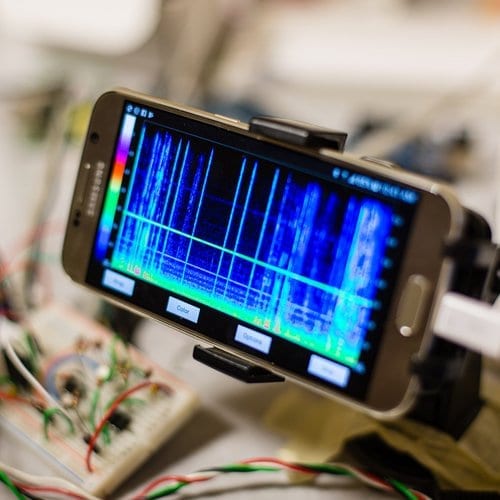
New embedded transducer approach allows surface acoustic wave device to transmit signals with six times the speed of most commercially used devices.
In today’s “internet of things,” devices connect primarily over short ranges at high speeds, an environment in which surface acoustic wave (SAW) devices have shown promise for years, resulting in the shrinking size of your smartphone. To obtain ever faster speeds, however, SAW devices need to operate at higher frequencies, which limits output power and can deteriorate overall performance. A new SAW device looks to provide a path forward for these devices to reach even higher frequencies.
A team of researchers in China has demonstrated a SAW device that can achieve frequencies six times higher than most current devices. With embedded interdigital transducers (IDTs) on a layer of combined aluminum nitride and diamond, the team’s device was also able to boost output significantly. Their results are published this week in Applied Physics Letters, from AIP Publishing.
“We have found the acoustic field distribution is quite different for the embedded and conventional electrode structures,” said Jinying Zhang, one of the paper’s authors. “Based on the numerical simulation analysis and experimental testing results, we found that the embedded structures bring two benefits: higher frequency and higher output power.”
Surface acoustic wave devices transmit a high-frequency signal by converting electric energy to acoustic energy. This is often done with piezoelectric materials, which are able to change shape in the presence of an electric voltage. IDT electrodes are typically placed on top of piezoelectric materials to perform this conversion.
Ramping up the operational frequency of IDTs — and the overall signal speed — has proven difficult. Most current SAW devices top out at a frequency of about 3 gigahertz, Zhang said, but in principle it is possible to make devices that are 10 times faster. Higher frequencies, however, demand more power to overcome the signal loss, and in turn, some features of the IDTs need to be increasingly small. While a 30 GHz device could transmit a signal more quickly, its operational range becomes limited.
“The major challenge is still the fabrication of the IDTs with such small feature sizes,” Zhang said. “Although we made a lot of efforts, there are still small gaps between the side walls of the electrodes and the piezoelectric materials.”
To ensure that the transducers had the proper feature size, Zhang’s team needed a material with a high acoustic velocity, such as diamond. They then coupled diamond, a material that changes its shape very little with electric voltage, with aluminum nitride, a piezoelectric material, and embedded the IDT inside their new SAW device.
The resulting device operated at a frequency of 17.7 GHz and improved power output by 10 percent compared to conventional devices using SAWs.
“The part which surprised us most is that the acoustic field distribution is quite different for the embedded and conventional electrode structures,” Zhang said. “We had no idea at all about it before.”
Zhang said she hopes this research will lead to SAW devices used in monolithic microwave integrated circuits (MMICs), low-cost, high-bandwidth integrated circuits that are seeing use in a variety of forms of high speed communications, such as cell phones.
Learn more: Acoustic device makes piezoelectrics sing to a different tune
The Latest on: Internet of things
[google_news title=”” keyword=”internet of things” num_posts=”10″ blurb_length=”0″ show_thumb=”left”]- Focus Universal Inc. Announces Board Approval for Spin-Off of Lusher Inc.on April 26, 2024 at 5:47 am
Chief Executive Officer Desheng Wang stated, "We are excited that our management team received authorization from our Board of Directors to start the spin-off process for Lusher Inc. Lusher Inc. which ...
- Shares of Internet of Things Play Impinj Soar on Strong Earnings and Outlookon April 25, 2024 at 8:02 am
Impinj stock skyrocketed Thursday after the chip provider offered robust guidance and better-than-expected earnings. The company manufactures radio-frequency identification, or RFID, chips for ...
- Internet of Things (IoT) Market to Expand at a Stellar 19.4% CAGR through 2031 | SkyQuest Technologyon April 25, 2024 at 3:45 am
Market will attain a value of USD 1572.37 billion by 2031, with a CAGR of 19.4% over the forecast period (2024-2031). Internet of Things (IoT) refers to the network of connected devices over the ...
- Internet of Things in Healthcare Market to Surge to USD 471.20 Billion by 2031: Industry Analysis, Technologies and Competitorson April 22, 2024 at 8:48 am
Internet of Things in Healthcare Market to Surge to USD 47120 Billion by 2031 Industry Analysis Technologies and Competitors ...
- Internet of Thingson April 21, 2024 at 5:00 pm
Silicon Labs is aiming at battery-free harvested energy applications with xG22E, a family of wireless microcontrollers covering Bluetooth Low Energy, 802.15.4 or proprietary 2.4 GHz links. “As Silicon ...
- Global X Internet of Things ETFon April 17, 2024 at 5:00 pm
Advice, rankings and one great story every day.
- Exploring the Digital Frontier: 10 Exciting Ways the Internet of Things Impacts Societyon April 17, 2024 at 7:07 am
In today’s rapidly evolving technological landscape, the Internet of Things (IoT) has emerged as a transformative force, revolutionizing the way we interact with the world around us. From smart homes ...
- Innovative Impact: 10 Ways the Internet of Things Redefines Our Worldon April 17, 2024 at 6:24 am
In today’s rapidly evolving technological landscape, the Internet of Things (IoT) stands out as a groundbreaking phenomenon. With its ability to connect devices and enable seamless communication ...
- The security minefield of the Internet of Thingson April 15, 2024 at 2:24 pm
When IoT devices run on outdated firmware or do not get updated regularly, they become easy targets for cybercriminals.
- Mode Inc. raises $8.75M to build generative AI assistant for the internet of thingson April 9, 2024 at 6:00 am
San Mateo, California-based Mode Inc. today announced it raised $8.75 million in new funding to accelerate the development of its generative artificial intelligence assistant for factories and ...
via Google News and Bing News










